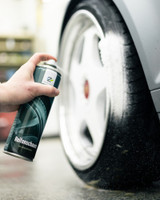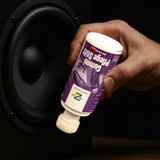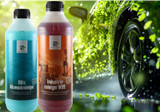Tire Dressings: What Lasts Longest and Why Quality Matters
Most car owners want tire shine that looks great, lasts long, and does not break the bank. One of the most common questions is about what is inside: Is it silicone-based? Is it water-based?
Not all tire shine products are created equal. Let's break down the differences so you know what is worth your money.
What Are Tire Dressings
If you think of tires as shoes, a good-looking set of tires finishes off a car's detail the way a pair of nice shoes completes the look of an outfit. Tire dressings are made to enhance the appearance of tires by providing a deep rich black finish while also protecting the rubber from environmental stress.
There are two main categories of tire dressings: water-based silicone emulsions and solvent-based dressings, which are made with silicone oil or petroleum. Here is how they compare.
Water-Based Dressings
Pros:
- Low sling risk
- Natural satin to semi-gloss finish
- Safer for rubber over the long term since they condition rather than dry
- Easier cleanup
Cons:
- Shorter durability, especially in rain or after a wash
- Needs more frequent reapplication

Solvent-Based (Silicone Oil or Petroleum-Based) Dressings
Pros:
- High gloss wet look finish
- More durable and water-resistant
- Typically lasts longer between applications
Cons:
- Can attract dust and dirt
- May sling onto paint if over-applied
- Cheaper petroleum-heavy formulas can dry rubber over time
- Strong odor during application
Overview
Water-based dressings used to have a reputation for being short-lived in terms of durability. Newer formulas, however, last much longer than they once did. Petroleum-based dressings often last longer, but their ability to attract dust and cause tires to age prematurely offsets their advantages.
The oily, high-gloss look is also less popular today, with more drivers preferring a clean satin finish. On top of that, stringent regulations have made it challenging for manufacturers to continue producing petroleum-based tire shines.
Does UV Protection in Tire Dressings Matter?
You know how tires tend to turn a brownish color? That is the protective UV and ozone inhibitors that continuously get pushed to the surface of the rubber as you drive. They are formulated into the rubber to prevent degradation. The problem with petroleum-based dressings is that they can break down these protective properties, leaving tires vulnerable to the damaging effects of UV and ozone.
Our trim and tire protectant, nextzett Vinyl-Rubber Extra, has UV protection, and nextzett Tire Foam offers both UV protection and anti-ozonants to guard against weathering. Of course, protection only matters if the product actually stays on the tire surface, which is why any treatment you use must be as weather-resistant as possible for long-lasting protection.
Which Lasts the Longest?
Solvent-based dressings typically outlast water-based ones, but it depends on the formulation. Today's water-based products hold their own. A product like nextzett Vinyl-Rubber Extra or Tire Foam compares well to many solvent-based dressings, especially solvent-based gels, which often deliver the shortest durability despite their thick texture.
Appearance is also an essential factor. The natural low-sheen finish is now preferred over the high-gloss look, so water-based dressings win on appearance.

Which Are Easiest to Apply?
- Water-based dressings are typically wipe-on, easier to control, and less messy.
- Aerosol foams such as nextzett Tire Foam offer the easiest application with quick, even coverage and minimal effort.
- Solvent-based gels require more effort to spread evenly, and if applied too heavily, they sling onto the paint once you start driving.
Can You Use Tire Dressing on Trim and Fenders?
Water-based dressings are generally safe for trim and vinyl surfaces. Solvent-based dressings, on the other hand, can leave streaks or stains and may cause adhesion issues if you switch to water-based later. To avoid this, you'll need to thoroughly clean the surface of any oily residue using a degreaser or a strong detergent like nextzett Plastic Deep Cleaner.
Why Quality Matters (vs Lower Cost Brands)
If there is one question on most people's minds, it is why pay almost twice as much for what looks like the same type of product?
It comes down to formulation. Higher-quality dressings utilize refined silicones and balanced carriers that condition the rubber without drying it out. Cheap dressings cut costs with petroleum solvents that evaporate quickly and leave the rubber worse off long term.
Tire manufacturers often see premature failure linked to low-quality dressings. A simple test: wipe a cracked tire, and if you see an oily residue on your finger, it is a sign of petroleum-heavy products at work.
Nextzett Tire Foam combines cleaning, conditioning, and shine in one. It costs more up front but saves money and time in the long run. It also contains UV protection and anti-ozonants similar to what tire manufacturers build into their tires.
Conclusion
For long-term tire health, easy application, and a clean, modern finish, choose a high-quality water-based dressing like nextzett Tire Foam or Vinyl-Rubber Extra.
Keep It Clean Detailing Blog
-
Tire Dressings: What Lasts Longest and Why Quality Matters
Sep 18, 2025Most car owners want tire shine that looks great, lasts long, and does not break the bank. One of th
-
Why Audiophiles Are Using Gummi Pflege on Speakers
Aug 07, 2025What Is Gummi Pflege Stift? Originally developed decades ago for automotive applications, Gummi Pfle
-
Sustainability: What it Means to Be NTA-Free
Jul 01, 2025There's no end to using the term "sustainability" – so much so that it may arguably lose meaning. Wh
- Read more articles




